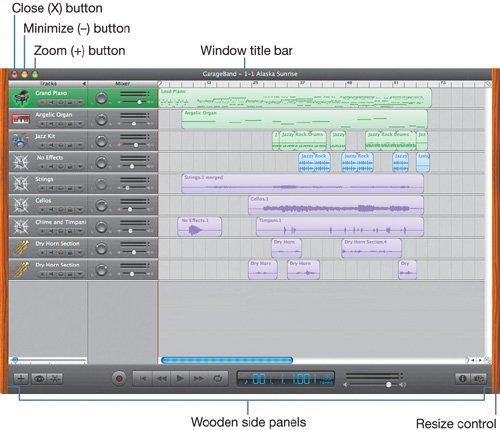| One of the many advantages of GarageBand is the simplicity of the interface. As with all the iLife applications, GarageBand uses one window as the base of operations. This window is your recording studio. Let's take a quick tour of the GarageBand window: Track headers Show the instrument icon and name to the left of each instrument track. The track headers also include a Mute button to silence a track, a Solo button to silence all other tracks, a Record Enable button (which allows you to record to a specific track), and a Lock button to protect the track and its contents from unintended changes. Track Mixer Includes a Volume slider to adjust the track volume and a Pan wheel to adjust the position of the track in the left-to-right stereo field. Timeline Acts as your music recording and arranging workspace. The Timeline is made up of horizontal tracks for each individual instrument. The Timeline graphically represents linear time from left to right using a Beat Ruler at the top of the window. The far-left edge of the Timeline represents the beginning of a song.  Zoom slider Zooms in to or out of the Timeline. Add Track button Adds a new track in the Timeline. Loop Browser button Opens the Loop Browser. Editor button Opens the editor. Transport controls Provide the standard recording and playback buttons to navigate in the Timeline, including Record, Go To Beginning, Rewind, Start/Stop Playback, Fast Forward, and Cycle. Time display Shows the song's tempo and current playhead position in musical time (measures, beats, ticks) or absolute time (hours, minutes, seconds, fractions). Instrument tuner Located in the same space as the time display; use it to check the tuning of any Real Instrument, including vocals. Master volume slider Adjusts the output volume level of the project. Level meters Indicate the output volume level of a project and include red warning lights if levels are clipping (too loud). Track Info button Opens the Track Info pane. Media Browser button Opens the Media Browser pane. The Media Browser is a new feature in GarageBand 3.
Window Basics GarageBand was designed for Macintosh OS X, and the GarageBand window works the same as other OS X windows. If you're new to the Mac or to OS X, it's a good idea to know the GarageBand window basics.  You can use the Zoom, Minimize, and Close buttons to resize the window, minimize it to the Dock, or to close the window and the project. Double-clicking the title bar at the top of the GarageBand window will also minimize the window. You can use the wooden side panels, top edge, or bottom edge to drag the window to a different location on the screen. To resize the entire window, drag the resize control in the lower-right corner of the window. Tip If you're using a laptop or a large studio display, the Zoom button is a very useful tool to maximize the size of your workspace. Also, any time you can't see the entire window because part of it is offscreen, you can click the Zoom button to bring the entire window into view.
Now that you know how to adjust the full GarageBand window, let's play the project and take a closer look at some other features, starting with the Timeline. |

